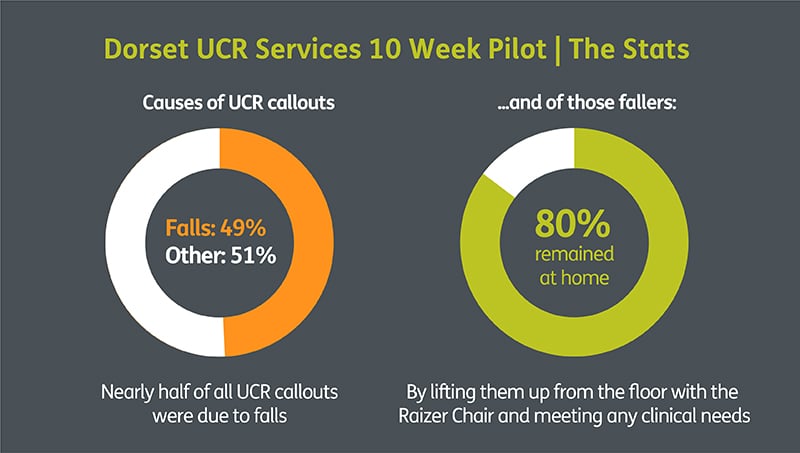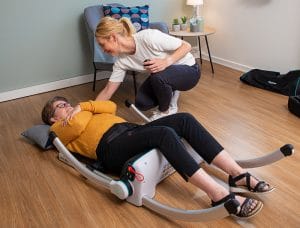Accelerating Urgent Community Response | 5 Key Insights
At the recent Felgains webinar on accelerating the coverage and capacity of Urgent Community Response (UCR) Services to deal with falls, we heard from two experts in urgent community response: Kathryn James, Clinical Support Manager at AACE; and Amy Hassan, Service Lead at Dorset UCR. Kathryn and Amy’s presentations were packed with informative, practical examples and advice on improving urgent community response to reduce pressure on the ambulance services.
There was plenty to take away and think about, so here are the 5 key insights gleaned from the expert clinicians on the webinar…
1. UCR teams can prevent thousands of unnecessary ambulance callouts and hospital admissions every year

As evidenced by the statistics from Amy’s pilot in Dorset, UCR teams can stop a lot of unnecessary ambulance callouts. Over the 10 week pilot, 49% of the UCR callouts were to falls. And of those fallers, 80% were kept in their own home by lifting them up from the floor quickly with the Raizer chair and meeting any clinical needs there and then.
Dorset UCRT have 4 cars and an average of 6 callouts, per car, per day. So of the 24 callouts they get every day, 12 are to falls, and they are able to keep 10 of those at home. So over the course of 12 months, they will be able to prevent 3,504 hospital admissions.
2. Fallers are waiting on the floor and coming to harm
Uninjured fallers are low priority (Category 3 and 4) for the ambulance service, so they will be waiting on the floor for a long time for an ambulance to arrive.
“We know now that the ambulance service is so stretched, that the real thing happening day to day is that patients are waiting on the floor – sometimes for hours – and they are coming to harm. So if we don’t respond as a system and just expect an ambulance to roll up 12 hours later, we’re going to cause harm.”
Cathryn James
Clinical Support Manager at AACE
If a fallen person experiences a ‘long lie’ (on the floor for over an hour) they will most likely come to harm, incurring tissue damage and or rhabdomyolysis. The resulting deconditioning means that when the ambulance does turn up, the fallen person needs to be admitted to hospital – when they wouldn’t have otherwise.
But with the right system in place, this is entirely avoidable.
3. There needs to be a system-wide approach to falls
The overwhelming message from the webinar was the importance of managing falls with a system-wide approach. Whether a fallen person is lifted up by the UCR team, local pendant alarm service or domiciliary care agency, the priority should be to get these fallen people off the floor. Then by offering wraparound clinical support – the ‘hospital at home’ approach – that person can remain in their own home.
To maximise the success of UCR Teams, it is very important that they have access to the 999 and 111 call stacks so they can pull off people who would otherwise wait a long time for an ambulance. Dorset UCRT achieved this by basing themselves at the 111 hub in Bournemouth. From there, they were able to directly pull off the call stack the people who they could help. Then by going to the person and providing a holistic assessment of their needs, they could prevent further falls or deterioration, and coordinate any needed community care.
“Since the 8th of November we’ve based ourselves in the 111 hub, and that’s where it’s made a huge difference – getting those patients that are currently not in our system.”
Amy Hassan
Service Lead at Dorset UCR
4. Blanket no-lift policies are unacceptable
The presence of UCR teams definitely doesn’t take away the need for care homes to be able to lift their fallen residents.
“As Yorkshire Ambulance Service have stated in their governance framework: It is quite unacceptable to call an emergency ambulance just to lift someone up from the floor”
Cathryn James
Clinical Support Manager at AACE
Blanket no-lift policies are unacceptable. Ambulance services have done a lot of work to try and get that message across to care organisations. In some cases, the ambulance service have trained, educated and supported care home staff on the need to have and operate their own lifting equipment. Simply put, care homes have a duty of care to their residents to be able to lift them up from the floor, rather than just relying on the ambulance service.
5. Anyone can get someone off the floor with the right equipment, skills and training
A fall can seem very complex and may feel like it requires a highly trained and experienced medical professional to lift them. However, it doesn’t need a paramedic. By using a falls algorithm to first check that the person is safe to lift, then using a lifting chair – as per the guidance on the NHS letter – you can get a fallen person up quickly and safely in a matter of minutes.
As Grant demonstrated in the webinar, The Raizer Lifting Chair helps you do just this – and with just one responder. (You can jump to 35.54 in the recording to watch Grant’s demo).
What is the Raizer?The Raizer is a motorised lifting chair that assembles around a fallen person and lifts them up to a seated or perching position. It is easy to assemble and use for the caregiver, and it is safe, smooth and very reassuring for the fallen person.
|
 |
As these 5 key insights show, by accelerating their coverage and capacity to deal with falls, UCR teams can make a real difference in reducing ambulance callouts. Add to that the clinical and system benefits of the ‘hospital at home’ approach, and the benefits are clear to see!
Reuben Bush
Reuben joined the Felgains team in August 2019, bringing with him passion and experience in marketing and design – from a rather different sector. His focus is now on improving each and every touchpoint of our customer experience and building a vast following of raving fans! He loves road cycling, and also happens to have rather a weakness for food – he’s a bona fide chocoholic!